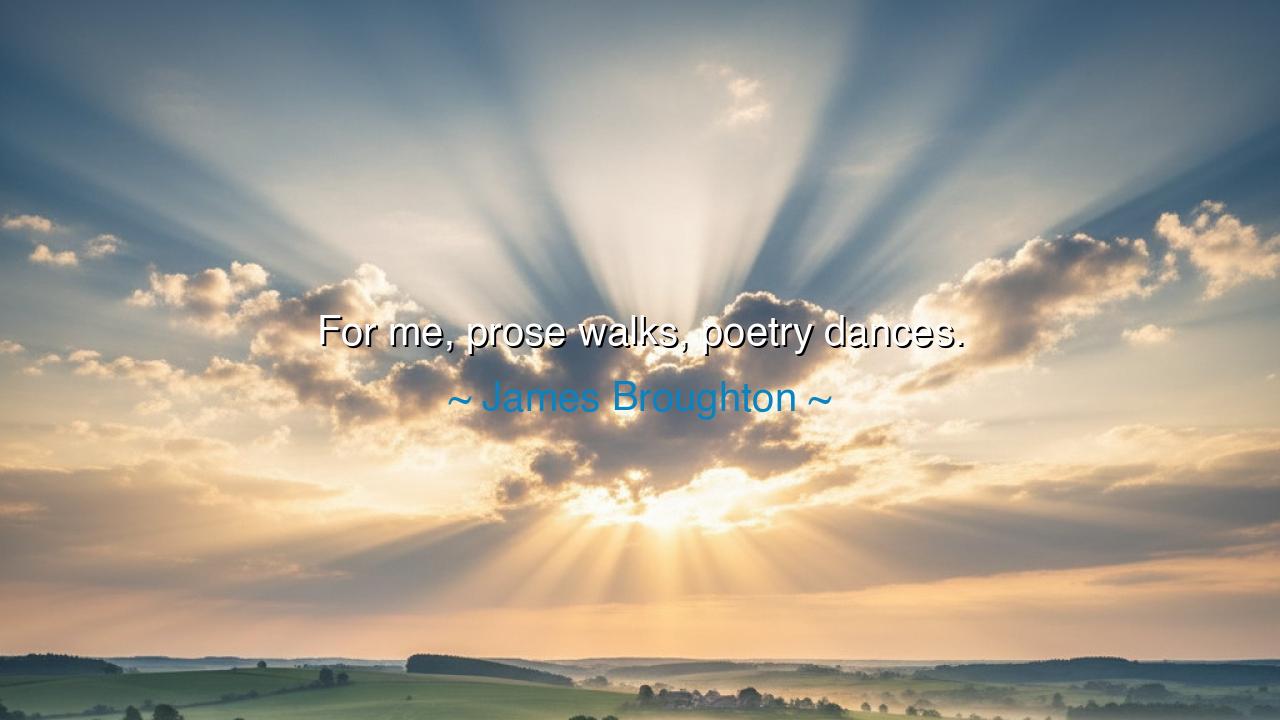
For me, prose walks, poetry dances.






“For me, prose walks, poetry dances.” Thus spoke James Broughton, the visionary poet and filmmaker, whose words remind us of the different spirits that dwell within language. In this simple yet radiant image, he sets apart two modes of expression: prose, steady and deliberate, like one who walks a measured road; and poetry, quickened with rhythm and grace, like one who cannot help but move to the unseen music of the universe.
The meaning of this saying is profound. Prose moves with utility, carrying information, building arguments, telling stories step by step. It is the march of reason, the pathway of narrative, the steady progress of thought. But poetry is not bound to such steps—it leaps, twirls, and flows. It is the art of rhythm, of compression, of revelation, where words themselves sway like bodies in a dance. Poetry does not merely tell; it enacts, it embodies, it becomes movement itself.
The origin of this thought lies in the very history of language. Before prose was written in long paragraphs, humanity’s first utterances of beauty were sung in verse. The hymns of the Vedas, the chants of the Psalms, the epic recitations of Homer—all were poetry, born to music, carried by memory. They were danced as much as spoken. It was only later that prose emerged, a tool for clarity and explanation. Thus Broughton echoes the memory of humanity’s beginnings: poetry has always been the dance of language.
Consider the story of Maya Angelou, who began as a dancer before she became one of America’s great poets. She carried the rhythm of movement into her words, so that even when she recited her verses, it was as though her voice itself danced. Her famous poem Still I Rise does not simply walk the reader through ideas—it sways, rises, and moves with defiance and grace. Angelou’s life embodies Broughton’s truth: poetry is the dance of spirit made visible in language.
The lesson here is luminous: choose your form with intention. When you seek to explain, to build, to carry others along a clear path—walk with prose. But when you wish to awaken, to stir, to lift the heart into music—let poetry dance. And in your own life, recognize moments that call for walking steadily, and moments that call for dancing freely. Wisdom lies in knowing the rhythm required.
History also gives us the example of Shakespeare, who wrote in both prose and verse. His characters of nobility often spoke in iambic pentameter—poetry, which danced across the stage. His clowns, servants, and commoners often spoke in prose, walking firmly in the language of daily life. This deliberate choice revealed a deep truth: prose grounds us on earth, poetry lifts us toward the heavens. Both are necessary, but their movements are different.
The practical teaching is this: let poetry into your days, not only as something to read, but as something to feel. Write verses even if rough, listen for rhythm in your speech, let music and movement shape your words. And when you work in prose, honor its steadiness, but remember that beyond the walk there is always the possibility of dance. For language is not only a tool, but also a body; and sometimes, the body must dance.
Thus the teaching endures: prose walks, poetry dances. Both belong to us, both carry us forward, but in different ways. Walk when the road requires it, dance when the soul compels it. For the fullness of life is not only to move steadily across the earth, but also to leap and spin in joy, as words themselves leap and spin when they become poetry.






NDKien Nguyen Duc
I’m intrigued by the visual and kinetic imagery in this observation. Does this mean that reading poetry feels like an experience of movement, rhythm, and expression, while prose is steady and predictable? I also question whether this view romanticizes poetry at the expense of prose, or simply highlights the unique qualities of each form. Could this distinction help us better appreciate how different literary forms evoke emotional and intellectual responses in readers?
NDNguyen ngoc diep
This makes me think about how form and content interact. Is Broughton implying that the essence of poetry is its vitality and dynamism, whereas prose is more utilitarian and linear? I also wonder whether the metaphor reflects his personal experience as a writer or performer—does he feel liberated by poetry’s dance-like quality, and more restrained by prose’s walk? Could this perspective encourage readers and writers to approach poetry with a sense of movement, improvisation, and play?
THThu Huong
I feel that this statement invites reflection on the physicality and musicality of language. If prose walks, does that imply a steady, measured pace, allowing for narrative development and logical progression? And if poetry dances, is it more concerned with movement, texture, and surprise than with straightforward conveyance of information? I also question whether this metaphor suggests that the boundaries between prose and poetry are flexible—can prose dance, or can poetry walk gracefully?
TDThuy Duong
This metaphor is captivating, suggesting a fundamental difference in energy and movement between prose and poetry. Does Broughton mean that poetry has a rhythm, grace, or freedom that prose lacks, or is it more about the way it engages the reader’s senses and emotions? I also wonder whether this implies that prose is more deliberate, structured, or grounded, while poetry is fluid, improvisational, and expressive. How does this distinction affect the way we approach reading or writing each form?